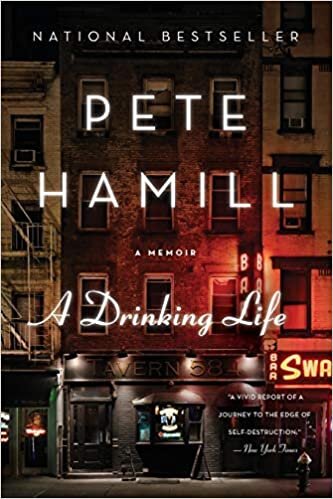Pete Hamill: A Drinking Life
/
There are two kinds of people in the world; those who were born and raised in New York City and those who wish they were. Pete Hamill’s A Drinking Life is a great book for both kinds of people. The memoir begins with his childhood rumblings half a block from Prospect Park where he discovered that drinking was an essential part of the code of being a man. He documents his own relationship with alcohol that was intertwined with celebrations, sex, friendship and religion. Hamill writes,
I didn’t know it at the time, but I had entered the drinking life. Drinking was part of being a man. Drinking was an integral part of sexuality, easing entrance to its dark and mysterious treasure chambers. Drinking was the sacramental binder of friendships. Drinking was the reward for work, the fuel of celebration, the consolation for death or defeat. Drinking gave me strength, confidence, ease, laughter; it made me believe that dreams really could come true. (146)
Hamill’s background as a reporter serves him well in the context of memoir. He checks the “Who, What, Why, Where and How” of each chapter. At the beginning of each chapter, Hamill places you in a location- 7th Avenue, the Subway, 13th Street, or Gallagher’s. Each location becomes a loved one, another character in his story. Hamill tells the reader who’s there with him in the scene; his mother, Mister Foppiano, Big Jack or Betty the Whore.
Hamill uses sensory descriptions to place the reader in the scene. The opening of the memoir is a perfect example of this, he lives “on the top floor of a brick building on a leafy street”, the “kitchen light was beautiful; suffused with a lemony green in summer” and smelled “of pine when my mother mopped the floors”, and his mother whistled “when she was happy, which was most of the time.” Hamill also connects booze to moments in his life, such as connecting with his drunken father,(17) friendships at camp,(78) his first sexual experience,(137) connecting with coworkers (182) and experiencing grief.
Another technique Hamill uses frequently is the list. He uses them to give a sweeping sense of the scene, like Sanew’s candy store where “behind the marble counter, spouts poured soda, seltzer, a variety of syrups in endless combinations (egg creams and lime rickeys and cherry Coke) and below the counter were silver-covered hidden places filled with tubs of ice cream.” (26) He uses lists to convey the overwhelming nature of war;
But the war went on. We learned its common and proper nouns; bomb, rifle, pillbox, Guadalcanal and grenade, camouflage and convoy, submarine and torpedo, Salerno and Monte Cassino, Rommel and Montgomery, infantry and air force, destroyers, PT boats, cruisers and carriers, casualties and conning towers, depth charges and bomb bay, antiaircraft, bazookas and howitzers, wounded, ambulance, shrapnel and flak, generals, colonels, majors, lieutenants, sergeants, corporals, privates, along with admirals, commandeers, captains and seamen, WACS and WAVES, 1A and 4F, Tojo and Mussolini, .45s and .88s, tanks and jeeps, occupation and refugee and resistance. (31)
Or to give the reader the feeling of frenzy at the end of the war; “everyone rushing around, waving newspapers, shouting, pumping clenched fists in the air.” (49). Hamill uses lists to speed up and condense time,
Marriage didn't end my drinking. Ramona didn't drink, but I did it for the both of us. There was lots of drinking at the wedding reception; drinking in Acapulco, where we went on our honeymoon; drinking to celebrate the birth of our first daughter, Adriene, drinking on the weekends; drinking on the way home from work.” (231)
On a personal note, I love the idea of utilizing lists in the way, especially the speeding up and condensing of time. I could see how this would be helpful in my own memoir work. I have noticed from many memoirs that there is a strange pacing that happens around three quarters of a way in. Lists might help to cover ground and keep up momentum in the pacing of the story.

